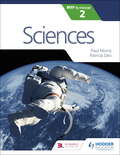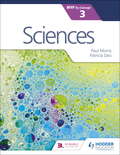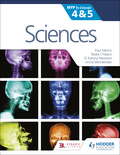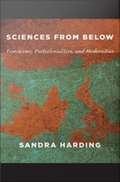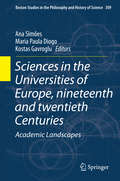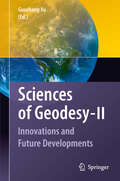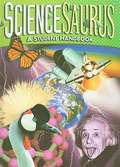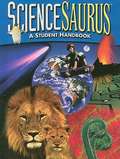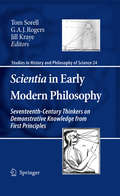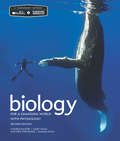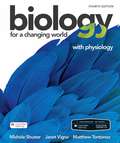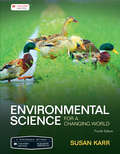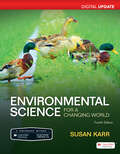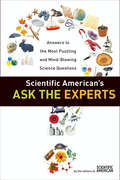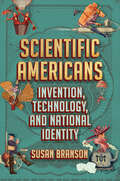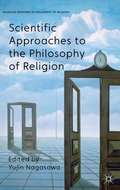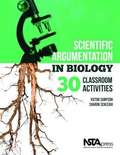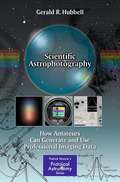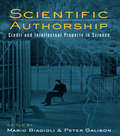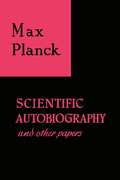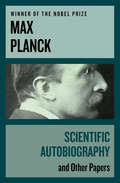- Table View
- List View
Sciences for the IB MYP 2
by Paul Morris Patricia DeoExam Board: IBLevel: MYPSubject: ScienceFirst Teaching: September 2016First Exam: June 2017Develop your skills to become an inquiring learner; ensure you navigate the MYP framework with confidence using a concept-driven and assessment-focused approach to Sciences presented in global contexts.- Develop conceptual understanding with key MYP concepts and related concepts at the heart of each chapter.- Learn by asking questions with a statement of inquiry in each chapter. - Prepare for every aspect of assessment using support and tasks designed by experienced educators.- Understand how to extend your learning through research projects and interdisciplinary opportunities.Contents list1 Where are we now and where are we going? 2 How do we map matter?3 Who are we? 4 How can we find out? 5 How does our planet work?6 How do we respond to our world?
Sciences for the IB MYP 3
by Paul Morris Patricia DeoA concept-driven and assessment-focused approach to Sciences teaching and learning.- Approaches each chapter with statements of inquiry framed by key and related concepts, set in a global context- Supports every aspect of assessment using tasks designed by an experienced MYP educator- Differentiates and extends learning with research projects and interdisciplinary opportunities- Applies global contexts in meaningful ways to offer an MYP Sciences programme with an internationally-minded perspective
Sciences for the IB MYP 3
by Paul Morris Patricia DeoA concept-driven and assessment-focused approach to Sciences teaching and learning.- Approaches each chapter with statements of inquiry framed by key and related concepts, set in a global context- Supports every aspect of assessment using tasks designed by an experienced MYP educator- Differentiates and extends learning with research projects and interdisciplinary opportunities- Applies global contexts in meaningful ways to offer an MYP Sciences programme with an internationally-minded perspective
Sciences for the IB MYP 4&5: MYP by Concept
by Paul Morris Radia Chibani Kahina Meziane Anna MichaelidesDevelop your skills to become an inquiring learner; ensure you navigate the MYP framework with confidence using a concept-driven and assessment-focused approach to Sciences presented in global contexts.· Develop conceptual understanding with key MYP concepts and related concepts at the heart of each chapter. · Learn by asking questions for a statement of inquiry in each chapter. · Prepare for every aspect of assessment using support and tasks designed by experienced educators.· Understand how to extend your learning through research projects and interdisciplinary opportunities.· Think internationally with chapters and concepts set in global contexts.
Sciences for the IB MYP 4&5: MYP by Concept
by Paul Morris Radia Chibani Kahina Meziane Anna MichaelidesDevelop your skills to become an inquiring learner; ensure you navigate the MYP framework with confidence using a concept-driven and assessment-focused approach to Sciences presented in global contexts.· Develop conceptual understanding with key MYP concepts and related concepts at the heart of each chapter. · Learn by asking questions for a statement of inquiry in each chapter. · Prepare for every aspect of assessment using support and tasks designed by experienced educators.· Understand how to extend your learning through research projects and interdisciplinary opportunities.· Think internationally with chapters and concepts set in global contexts.
Sciences from Below: Feminisms, Postcolonialities, and Modernities
by Sandra HardingIn Sciences from Below, the esteemed feminist science studies scholar Sandra Harding synthesizes modernity studies with progressive tendencies in science and technology studies to suggest how scientific and technological pursuits might be more productively linked to social justice projects around the world. Harding illuminates the idea of multiple modernities as well as the major contributions of post-Kuhnian Western, feminist, and postcolonial science studies. She explains how these schools of thought can help those seeking to implement progressive social projects refine their thinking to overcome limiting ideas about what modernity and modernization are, the objectivity of scientific knowledge, patriarchy, and Eurocentricity. She also reveals how ideas about gender and colonialism frame the conventional contrast between modernity and tradition. As she has done before, Harding points the way forward in Sciences from Below. Describing the work of the post-Kuhnian science studies scholars Bruno Latour, Ulrich Beck, and the team of Michael Gibbons, Helga Nowtony, and Peter Scott, Harding reveals how, from different perspectives, they provide useful resources for rethinking the modernity versus tradition binary and its effects on the production of scientific knowledge. Yet, for the most part, they do not take feminist or postcolonial critiques into account. As Harding demonstrates, feminist science studies and postcolonial science studies have vital contributions to make; they bring to light not only the male supremacist investments in the Western conception of modernity and the historical and epistemological bases of Western science but also the empirical knowledge traditions of the global South. Sciences from Below is a clear and compelling argument that modernity studies and post-Kuhnian, feminist, and postcolonial sciences studies each have something important, and necessary, to offer to those formulating socially progressive scientific research and policy.
Sciences in the Universities of Europe, Nineteenth and Twentieth Centuries
by Ana Simões Maria Paula Diogo Kostas GavrogluThis book focuses on sciences in the universities of Europe in the nineteenth and twentieth centuries, and the chapters in it provide an overview, mostly from the point of view of the history of science, of the different ways universities dealt with the institutionalization of science teaching and research. A useful book for understanding the deep changes that universities were undergoing in the last years of the 20th century. The book is organized around four central themes: 1) Universities in the longue durée; 2) Universities in diverse political contexts; 3) Universities and academic research; 4) Universities and discipline formation. The book is addressed at a broad readership which includes scholars and researchers in the field of General History, Cultural History, History of Universities, History of Education, History of Science and Technology, Science Policy, high school teachers, undergraduate and graduate students of sciences and humanities, and the general interested public.
Sciences of Geodesy - I
by Guochang XuThis reference and handbook includes contributions from the world's leading experts and describes the history, theory, development, research highlights, problems and future of the individual geodetic fields. The subjects include: Geodesy, Satellite Geodesy, Marine Geodesy, GPS / Galileo Systems, Navigation and Positioning, Aerogravimetry, Super-conducting Gravimetry, Adjustment and Filtering, Orbits Theory, Orbits Determination, Tectonics, Earth Rotation and Polar Motion, Earth Tide and Ocean Loading Tide, Satellite Altimetry, Remote Sensing, InSAR, etc.
Sciencesaurus: A Student Handbook
by Great Source Education GroupThis book addresses key science topics including: scientific investigation; working in the lab; life science; earth science; physical science; natural resources and the environment; science, technology, and society. An ideal resource in science class, during lab time, and at home, this book also includes a handy almanac with tables, charts and graphs, test-taking and researching skills, science timelines and glossaries, and more.
Sciencesaurus: Student Handbook
by Great Source Education Group StaffHelping you learn more about science
Scientia in Early Modern Philosophy
by Tom Sorell Jill Kraye G. A. RogersScientia is the term that early modern philosophers applied to a certain kind of demonstrative knowledge, the kind whose starting points were appropriate first principles. In pre-modern philosophy, too, scientia was the name for demonstrative knowledge from first principles. But pre-modern and early modern conceptions differ systematically from one another. This book offers a variety of glimpses of this difference by exploring the works of individual philosophers as well as philosophical movements and groupings of the period. Some of the figures are transitional, falling neatly on neither side of the allegiances usually marked by the scholastic/modern distinction. Among the philosophers whose views on scientia are surveyed are Hobbes, Descartes, Spinoza, Gassendi, Locke, and Jungius. The contributors are among the best-known and most influential historians of early modern philosophy.
Scientific American Biology
by Janet Vigna Gunjan Sinha Matthew Tontonoz Michèle ShusterFrom the groundbreaking partnership of W. H. Freeman and Scientific American comes this one-of-a-kind introduction to the science of biology and its impact on the way we live. In Biology for a Changing World, two experienced educators and a science journalist explore the core ideas of biology through a series of chapters written and illustrated in the style of a Scientific American article. Chapters don't just feature compelling stories of real people--each chapter is a newsworthy story that serves as a context for covering the standard curriculum for the non-majors biology course. Updated throughout, the new edition offers new stories, additional physiology chapters, a new Electronic Teachers' Edition, and new pedagogy. See what's in the LaunchPad
Scientific American Biology for a Changing World with Physiology
by Michele Shuster Janet Vigna Matthew TontonozBiology for a Changing World with Physiology is a textbook you�ll actually want to read. By presenting the science through compelling Scientific American style stories, this book will help you understand the relevance of biology to your world.
Scientific American Environmental Science for a Changing World
by Susan KarrAvailable for the first time with Macmillan's new online learning tool, Achieve, Susan Karr’s Environmental Science for a Changing World 4e uses an engaging, journalistic approach—real stories about real people—to show students how science works and how to think critically about environmental issues. Each module reads like a single, integrated Scientific American-style article with clear explanations of essential processes and concepts enhanced with beautifully designed infographics.
Scientific American Environmental Science for a Changing World, Digital Update
by Susan KarrReal people. Real stories. Real science.Scientific American Environmental Science for a Changing World 4e Digital Update uses magazine-style stories and cutting-edge digital resources to help you understand how the science of environmental science works.
Scientific American's Ask the Experts: Answers to The Most Puzzling and Mind-Blowing Science Questions
by Editors of Scientific AmericanWhy is the night sky dark? How do dolphins sleep without drowning? Why do hangovers occur? Will time travel ever be a reality? What makes a knuckleball appear to flutter? Why are craters always round?There's only one source to turn to for the answers to the most puzzling and thought-provoking questions about the world of science: Scientific American. Writing in a fun and accessible style, an esteemed team of scientists and educators will lead you on a wild ride from the far reaches of the universe to the natural world right in your own backyard. Along the way, you'll discover solutions to some of life's quirkiest conundrums, such as why cats purr, how frogs survive winter without freezing, why snowflakes are symmetrical, and much more. Even if you haven't picked up a science book since your school days, these tantalizing Q & A's will shed new light on the world around you, inside you, below you, above you, and beyond!
Scientific Americans: Invention, Technology, and National Identity
by Susan BransonIn Scientific Americans, Susan Branson explores the place of science and technology in American efforts to achieve cultural independence from Europe and America's nation building in the early republic and antebellum eras. This engaging tour of scientific education and practices among ordinary citizens charts the development of nationalism and national identity alongside roads, rails, and machines.Scientific Americans shows how informal scientific education provided by almanacs, public lectures, and demonstrations, along with the financial encouragement of early scientific societies, generated an enthusiasm for the application of science and technology to civic, commercial, and domestic improvements. Not only that: Americans were excited, awed, and intrigued with the practicality of inventions. Bringing together scientific research and popular wonder, Branson charts how everything from mechanical clocks to steam engines informed the creation and expansion of the American nation. From the Exhibition of the Industry of All Nations to the fate of the Amistad captives, Scientific Americans shows how the promotion and celebration of discoveries, inventions, and technologies articulated Americans' earliest ambitions, as well as prejudices, throughout the first American century.
Scientific Approaches to the Philosophy of Religion
by Yujin NagasawaThe philosophy of religion, one of the oldest areas of philosophy, has been advanced mainly through conceptual thinking. However, over the last few decades scientists have made discoveries with significant implications for this philosophical domain. Scientific Approaches to Philosophy of Religion opens new perspectives by applying scientific approaches to central problems in the field. The book's contributors tackle perennial problems in philosophy of religion by referring to relevant findings and theories in cognitive science, anthropology, developmental psychology, decision theory, biology, physics and cosmology. They address a wide range of topics, such as divine attributes; God, creation and evolution; God and the universe; religious beliefs; religious tolerance and disagreement; and the compatibility of science and religion.
Scientific Argumentation In Biology: 30 Classroom Activities
by Victor Sampson Sharon SchleighDevelop your high school students' understanding of argumentation and evidence-based reasoning with this comprehensive book. Like three guides in one, Scientific Argumentation in Biology combines theory, practice, and biology content. It starts by giving you solid background in why students need to be able to go beyond expressing mere opinions when making research-related biology claims. Then it provides 30 thoroughly field-tested activities your students can use when learning to: propose, support, and evaluate claims; validate or refute them on the basis of scientific reasoning; and craft complete written arguments. Detailed teacher notes suggest specific ways in which you can use the activities to enrich and supplement (not replace) what you're doing in biology class already. Scientific Argumentation is an invaluable resource for learning more about argumentaion and designed related lessons. You'll find it ideal for helping your students learn standards-based content; improve their biological practices; explain, interpret, and evaluate evidence; and acquire the habits of mind to become proficient in science.
Scientific Astrophotography
by Gerald HubbellScientific Astrophotography is intended for those amateur astronomers who are looking for new challenges, once they have mastered visual observing and the basic imaging of various astronomical objects. It will also be a useful reference for scientifically inclined observers who want to learn the fundamentals of astrophotography with a firm emphasis on the discipline of scientific imaging. This books is not about making beautiful astronomical images; it is about recording astronomical images that are scientifically rigorous and from which accurate data can be extracted. This book is unique in that it gives readers the skills necessary for obtaining excellent images for scientific purposes in a concise and procedurally oriented manner. This not only gets the reader used to a disciplined approach to imaging to maximize quality, but also to maximize the success (and minimize the frustration!) inherent in the pursuit of astrophotography. The knowledge and skills imparted to the reader of this handbook also provide an excellent basis for "beautiful picture" astrophotography! There is a wealth of information in this book - a distillation of ideas and data presented by a diverse set of sources and based on the most recent techniques, equipment, and data available to the amateur astronomer. There are also numerous practical exercises. Scientific Astrophotography is perfect for any amateur astronomer who wants to go beyond just astrophotography and actually contribute to the science of astronomy.
Scientific Authorship: Credit and Intellectual Property in Science
by Mario Biagioli Peter GalisonFirst Published in 2003. Routledge is an imprint of Taylor & Francis, an informa company.
Scientific Autobiography and Other Papers
by Max PlanckIn this fascinating autobiography from the foremost genius of twentieth-century physics, Max Planck tells the story of his life, his aims, and his thinking. Published posthumously, the papers in this volume were written for the general reader and make accessible his scientific theories as well as his philosophical ideals, including his thoughts on ethics and morals. Max (Karl Ernst Ludwig) Planck was a German physicist and philosopher known for his quantum theory, for which he won the Nobel Prize in Physics in 1918. Planck was born in Kiel, Germany, in 1858 to an academic family, and he valued education from a young age. He attended the Universities of Munich and Berlin to study physics under the great scientific leaders Kirchhoff and Helmholtz. His early work mainly focused on the study of thermodynamics, and in 1900 he published a paper on his quantum theory that would change the face of modern physics. Planck worked as a professor at Berlin University his entire life, and he also served as the president of the Kaiser Wilhelm Society for the Promotion of Science. During World War II, Planck experienced great hardships while he remained in Germany but openly opposed the Nazi regime. One of his two sons was executed during this time for an unsuccessful attempt on Hitler’s life, and Planck’s home in Berlin was eventually bombed. He continued to write on physics and philosophy until his death in 1947.
Scientific Autobiography: And Other Papers
by Max PlanckIn this fascinating autobiography from one of the foremost geniuses of twentieth-century physics, Max Planck tells the story of his life, his aims, and his thinking. Published posthumously, the papers in this volume were written for the general reader and make accessible Planck&’s scientific theories as well as his philosophical ideals, including his thoughts on ethics and morals.
